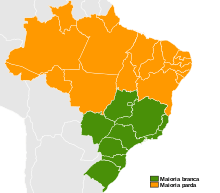Majority minority
A majority–minority or minority–majority area is a term used in the United States to refer to a jurisdiction in which one or more racial and/or ethnic minorities (relative to the whole country's population) make up a majority of the local population. The term is often used in Voting Rights to designate voting districts which are altered under the Voting Rights Act to enable ethnic or language minorities "the opportunity to elect their candidate of choice."[1] In that context, the term is first used by the Supreme Court in 1977.[2] The Court had previously used the term in employment discrimination and labor relations cases.[3]
United States

In the United States of America majority–minority or minority–majority area is a United States state or jurisdiction whose population is composed of less than 50% non-Hispanic whites. Racial data is derived from self-identification questions on the U.S. Census and on U.S. Census Bureau estimates. (See Race and ethnicity in the United States Census).
- Four states are majority–minority as of 2010: Hawaii (which is the only state that has never had a white majority), New Mexico, California, and Texas.[4]
- The District of Columbia reached a majority black status during the latter stages of the Great Migration. Although the district is still majority–minority, blacks now make up only 48.3% of the population; increases have been among minorities who identify as Asians and Hispanics. Whites have also moved into the district in increasing number since the turn of the 21st century.[5]
- The percentage of non-Hispanic white residents has fallen below 60% in Maryland, Georgia, Nevada, Florida, Arizona, New York, New Jersey, Mississippi, and Louisiana.
- All populated United States territories (Puerto Rico, Guam, the U.S. Virgin Islands, the Northern Mariana Islands, and American Samoa) are majority–minority areas. They never had a non-Hispanic white majority.
- As of 2012, 50 metropolitan areas in the U.S. are majority–minority.[6]
- As of 2015, 12% of U.S. counties are majority–minority.[7]
- The whole United States of America is projected to become majority–minority in 2043.[8] With alternate immigration scenarios, the whole U.S. is projected to become majority–minority sometime between 2041 and 2046 (depending on the amount of net immigration into the U.S. over the next 35 years).[9][10]
- Minority children will be the majority in the entire United States by 2019.[11]
- Minority children are the majority among children in the following ten states: California, Nevada, New Mexico, Arizona, Texas, Florida, Georgia, Hawaii, Mississippi, and Maryland.[12]
States
From colonial times to the early 20th century, much of the Lower South had a black majority. Three Southern states had populations that were majority black: Louisiana (until about 1890[13]), South Carolina (until the 1920s[14]) and Mississippi (from the 1830s to the 1930s[15]). In the same period, Georgia,[16] Alabama,[17] and Florida,[18] had populations that were nearly 50% black, while Maryland,[19] North Carolina,[20] and Virginia[21] had black populations approaching or exceeding 40%. Texas' black population reached to 30%.[22]
The demographics of these states changed markedly from the 1890s through the 1950s, as two waves of the Great Migration led more than 6.5 million African Americans to abandon the economically depressed, legally segregated Deep South in search of better job opportunities and living conditions, first in Northern and Midwestern industrial cities, and later west to California. One-fifth of Florida's black population had left the state by 1940, for instance.[23] During the last 30 years of the 20th century into the 21st century, scholars have documented a reverse New Great Migration of blacks back to southern states, but typically to destinations in the New South, which have the best jobs and developing economies.[24]
The District of Columbia, one of the magnets for Great Migration blacks, was long the sole majority–minority federal jurisdiction in the continental U.S. The black proportion has declined since the 1990s due to gentrification and expanding opportunities, with many blacks moving to suburban Maryland and others migrating to jobs in states of the New South in a reverse of the Great Migration.[24] In 2015 the black population represented only 48.3% of the population—a considerable decline from 75% which in the late 1970s. At the same time, Asians and Hispanics have increased in the District, keeping it majority–minority.
Since 1965, foreign immigration has spurred increases in the number of majority–minority areas, most notably in California.[25] Its legal resident population was 89.5% 'non-Hispanic white' in the 1940s, but in 2015 was estimated at 38.0% 'non-Hispanic white.[26]
Cities
Many cities in the United States became majority–minority by 2010.[27] Out of the cities that had a peak population of 500,000 or more before 1990, the cities now classified as majority–minority include Phoenix,[28] Los Angeles, San Diego,[29] San Francisco, San Jose, Washington D.C., Chicago, Baltimore, Boston,[30] Detroit, St. Louis,[31] Buffalo,[32] New York City, Tampa, Cincinnati,[33] Cleveland, Philadelphia,[34] Milwaukee,[35] New Orleans, Charlotte, Memphis, Dallas, El Paso, Houston, and San Antonio.[27][36]
Data collection
The first data for New Mexico was a 5% sample in 1940 which estimated non-Hispanic whites at 50.9%.[37] Hispanics do not constitute a race but an ethnic and cultural group: of respondents who listed Hispanic origin, some listed White race, roughly half gave responses tabulated under "Some other race" (e.g. giving a national origin such as "Mexican" or a designation such as "Mestizo" as race), and much smaller numbers listed Black, Native American, or Asian race.
In U.S. censuses since 1990, self-identification has been the primary way to identify race. Presumption of race based on countries or regions given in the ancestry question is used only when a respondent has answered the ancestry question but not the race question. The U.S. Census currently defines "white people" very broadly as "people having origins in any of the original peoples of Europe, the Middle East, or North Africa,[38] i.e. Caucasoids. This definition has changed through the years.
Although the Census attempts to enumerate both citizens and non-citizens, the illegal immigrant population of the United States has proven hard to quantify; the census uses a 12 million base estimate nationally. However, current estimates based on national surveys, administrative data and other sources of information indicate that the current population may range as high as 20 to 30 million.[39]
Maps and graphs
| Area | White (all) | Non-Hispanic White | Asian American | African American | Hispanic or Latino American | Native American | Native Hawaiian | Two or more races |
|---|---|---|---|---|---|---|---|---|
| California | 57.6% | 40.1% | 13.0% | 6.2% | 37.6% | 1.0% | 0.4% | 4.9% |
| Hawaii | 24.7% | 22.7% | 38.6% | 1.6% | 8.9% | 0.3% | 10.0% | 23.6% |
| New Mexico | 68.4% | 40.5% | 1.4% | 2.1% | 46.3% | 9.4% | 0.1% | 3.7% |
| Texas | 70.4% | 45.3% | 3.8% | 11.8% | 37.6% | 0.7% | 0.1% | 2.7% |
| District of Columbia | 38.5% | 34.8% | 3.5% | 50.7% | 9.1% | 0.3% | 0.1% | 2.9% |
| United States | 72.4% | 63.7% | 4.8% | 12.6% | 16.3% | 0.9% | 0.2% | 2.9% |
SOURCE: U.S. Census Bureau, 2005 (for the year 2000)





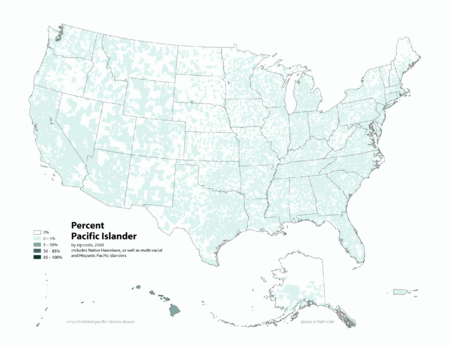
Other uses
Normally, a state is considered to be majority–minority because of its ethnic/racial makeup, but other criteria is occasionally used, such as religion, disability, or age. For example, the majority of Utah residents are Mormons, a Christian denomination that is a religious minority throughout the rest of the United States. In addition to Utah, Rhode Island and Louisiana, which have Roman Catholic majorities, are the only states in the U.S. where a single denomination constitutes a majority of the population. However, no U.S. state has a majority composed of any non-Christian group, except for Hawaii, where 51.1% of the population follow religions that would be non-mainstream in the rest of the United States. Hawaii is classified as religious majority of Unaffiliated, including agnostics, atheists, humanists, the irreligious, and Secularists (non-practicing).
Criticism
In January 2016, CUNY sociologist Richard Alba wrote an article in the American Prospect arguing that the way in which majority-minority calculations are made by the Census are misleading. Anyone with any Hispanic, Asian, or Black ancestry is seen as non-white, even if they also have white ancestry. Alba argues that the incomes, marriage patterns, and identities of people of who are mixed Hispanic-white and Asian-white are closer to those of white people than monoracial Hispanics or Asians. Thus, when the Census says that non-white Hispanics are projected to be less than 50% of the population by the 2040s, people of mixed-race ancestry are improperly excluded from that category.[40]
International applications
While the concept exists in other nations, the exact term differs from place to place and language to language.
In many large, contiguous countries like China, there are many autonomous regions where a minority population is the majority. These regions are generally the result of historical population distributions, not because of recent immigration or recent differences in birth and fertility rates between various groups.
English-speaking countries
Australia
European Australians are a minority in some of Sydney's western suburbs. Fairfield and Cabramatta in Fairfield City Council, Lakemba and Bankstown in Canterbury-Bankstown Council, and Auburn in Cumberland Council, are one of the largest non-European suburbs in Australia.[41] Here is a list of the suburbs in Sydney's metropolitan area where non-European ethnic groups are the majority:
- Vietnamese people in the greater western suburbs of Cabramatta,[42] Canley Vale, Canley Heights, Carramar, Birrong, and in the suburbs of Fairfield East, Fairfield West, St John's Park, Bonnyrigg, Wakeley and Green Valley, which also have a large Assyrian community.[41] Furthermore, people of Chinese ancestry are also significant in these suburbs.[41]
- Chinese people in the suburbs towards Inner West Sydney, such as, Haymarket (Chinatown), Canterbury Eastwood, Enfield, Campsie, Meadowbank, Rhodes, Newington, Homebush, Ashfield, Burwood, Strathfield and Berala, Regents Park and Auburn. These suburbs also have a significant amount of Lebanese people.[41]
- Lebanese people in Lakemba, Bass Hill, Yagoona, Condell Park, Sefton, Greenacre, Belfield, Bankstown, Merrylands, Punchbowl, Granville, Yagoona, Villawood and Guildford.[43][44][45][46]
- Indian people in the northwest suburbs of Sydney, such as, Parramatta, Harris Park, Girraween, Pendle Hill, Westmead, Wentworthville, Holroyd, Rosehill, and a few suburbs in South-western Sydney, such as, Glenfield[41] and Ingleburn.[41]
- Assyrian people in the greater western suburbs of Fairfield, Fairfield Heights and Greenfield Park.[47]
- Filipino people in the northwestern suburbs of Rooty Hill,[41] Plumpton[41] and Mount Druitt.[48] Moreover, Indians are the second largest ethnicity in these suburbs[41]
Canada
- Unlike the United States where there are four (4) minority-majority states, none of the Canadian provinces is minority-majority. It must be noted that the definition of a minority differs between US and Canada, since, whereas in the US this term includes anyone who is either not white or who is Hispanic (Hispanic whites are considered as minority), in Canada it is defined (by the Employment Equity Act, used by Statistics Canada) as "persons, other than Aboriginal peoples, who are non-Caucasian in race or non-white in colour." Thus, (a) Aboriginals are considered majority, (b) Hispanic whites are considered majority, but (c) non-white Arabs and West Asians are considered minority, even if Caucasian in race. However, the numbers are not close, so this difference does not bear any practical significance except for the territory of Nunavut, which would be minority-majority if the US-style definition of racial minority were to be applied (24,875 of 29,325 residents are Inuit).
- The province with the highest proportion of visible minorities (2006 Census) is British Columbia (24.8%), followed by Ontario (22.8%). This means that in no Canadian province has the percentage of the racial majority (Aboriginals + White Caucasians) yet fallen under 75%.
- No census metropolitan area (CMA) is minority–majority yet. However, Toronto and Vancouver CMAs are on the tip of becoming such; in particular, according to the 2006 Census, the Toronto CMA has 42.9% of visible minorites, while the Vancouver CMA has 41.7% of visible minorities. These are the only metropolitan areas in Canada where the percentage of the racial majority has fallen under 60%. Taking into account the 20 largest census metropolitan areas, Calgary comes a distant third with 22.2%.
- Racial or "visible minorities" (as they are known in Canada) are the majority in Vancouver proper and are expected to become the majority in the City of Toronto by 2016 or 2017.
- The Toronto district of Scarborough has a population made up of 67.4% visible minorities; all but one of the ten Scarborough wards are visible-minority-majority, of which, in particular, Scarborough-Agincourt and Scarborough-Rouge River are Chinese-majority (53.4% and 57.3% respectively; 83.7% and 87.8% respectively for all visible minorities). Likewise, 19 of 25 Scarborough neighbourhoods (as designated by the City of Toronto) are visible-minority-majority. For purposes of contradistinction, in the "Old" (pre-amalgamation) City of Toronto, 68% of the population are white Caucasian (or Aboriginal) and the visible-minority-majority neighbourhoods are five in a total of 44 neighbourhoods (Regent Park, North St. James Town, Bay Street Corridor, Kensington-Chinatown, and Parkdale).
- The Toronto suburbs of Markham (65.4%) and Brampton (66.4%) also have a minority–majority population, of primarily Chinese and East Indian ethnic origin respectively.
- The Vancouver suburbs of Richmond (74.6%) and Burnaby (54.1%) also have a minority-majority population, of primarily Chinese ethnic origin in both cases.
- The French linguistic minority is the majority in the province of Quebec (79.0% have French as their mother tongue, according to the 2006 Census), and has been since before Canadian Confederation.
- The province of Saskatchewan may also have an Aboriginal majority by 2050, according to some research.[49]
- Regarding religion (2001 Census data), Quebec and New Brunswick have a Roman Catholic majority, while Newfoundland and Labrador and Nunavut have a Protestant majority. In the other provinces and territories, no denomination exceeds the 50% mark; however, Protestants are the largest denomination first in all provinces and territories except only Prince Edward Island and Northwest Territories where Catholics are the largest denomination. No other Christian denomination, other religion, or lack of religious affiliation as first or second in any province or territory.
Visible Minority Majorities in different Canadian municipalities: British Columbia
- Richmond (70.4%)
- Greater Vancouver A (62.1%)
- Burnaby (59.5%)
- Surrey (52.6%)
- Vancouver (51.8%)
Ontario
- Markham (72.3%)
- Brampton (66.4%)
- Mississauga (53.7%)
- Richmond Hill (52.9%)
England
- White British (mainly English people) are a minority in London (43.7%).[50]
- English people are also a minority in Luton, Slough, Leicester and Birmingham.
New Zealand
- European New Zealanders are a minority in six of Auckland's local board areas (Whau, Puketapapa, Maungakiekie–Tamaki, Mangere–Otahuhu, Otara–Papatoetoe, and Manurewa) and the Wairoa District.[51]
- The indigenous Māori people form a majority in the Kawerau, Opotiki and Wairoa Districts, and the Chatham Islands Territory.[51]
- Pacific peoples form a majority in the Mangere–Otahuhu local board area of Auckland.[51]
South Africa

- Whites and Coloured South Africans are a majority in some parts of South Africa while being a minority in South Africa overall.
Brazil
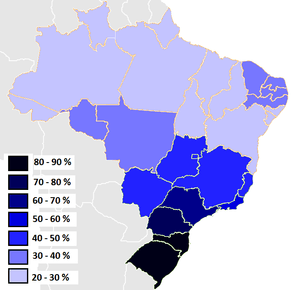
Brazil has officially become a majority "non-white" country as of the 2010 census,[52] together with the federative units of Goiás, Federal District, Minas Gerais and Espírito Santo.
Those identifying as white declined to 47.7 percent (about 91 million people) in 2010 census from 52.9 percent (about 93 million people) in 2000 in the entire country.[52] However, in Brazil, this is not simply a matter of origin and birthrate, but identity changes as well. The black minority, whose women have more children in average than the pardo minority, did not enlarge its representation in the population to more than 1.5% in the period, while it was mostly the growth in the number of pardo people (~38% in 2000, 42.4% in 2010) that caused the demographic plurality of Brazil.
However, a process similar to that of the United States is indeed happening in Brazil, for a longer amount of time but at a much slower pace. See White Brazilian#By state.
Bulgaria
- Turks outnumber Bulgarians in Kardzhali and Razgrad Provinces (Bulgarians are a huge majority in Bulgaria overall).[53]
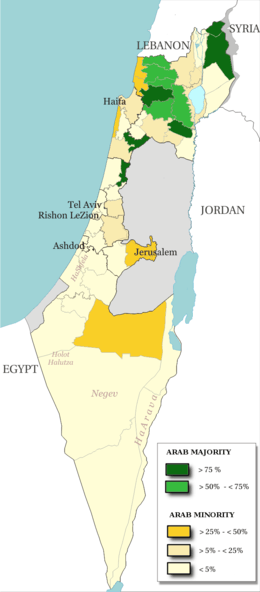
Fiji
- Fiji did not have any racial or ethnic group comprise a majority from the 1930s to the 1990s, with the exception of the 1960s and possibly early 1970s.[54]
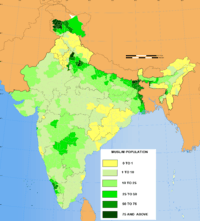
India
- Muslims are a majority in the Lakshadweep and Jammu and Kashmir states/territories of India, and in some other districts of India. However, Muslims are a minority in India overall.
Israel
- Arabs are a majority of the population in Israel's Northern District and in several natural regions in other parts of Israel.[55]
- Non-Haredi Jews are projected to become a minority of Israel's total population by 2059.[56][57]
Romania
- Harghita and Covasna provinces in Romania have a Hungarian majority, while Romania as a whole has a Romanian majority.[58]
Slovakia
- Slovakia has some places/areas where Slovaks are a minority and Hungarians are a majority.[59]
Sri Lanka
- Sinhalese are minority in Northern Province, Eastern Province and most parts of the Colombo.[60]
(Former) Union of Soviet Socialist Republics
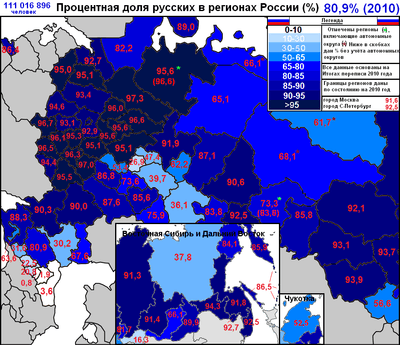
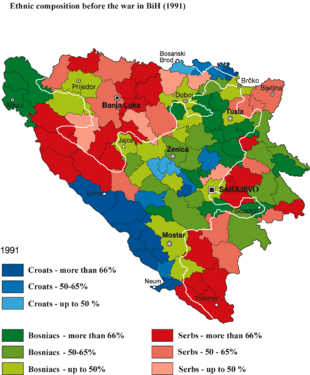
Abkhazia (Georgia)
- No ethnic group composed a majority of the population in Abkhazia from at least 2003 until around 2011.[61][62]
Azerbaijan
Belarus
- Belarusians are a minority in some parts of Belarus.[64]
Estonia
- While Estonians form a majority of the population in Estonia overall, Russians made up a majority in Ida-Viru County, parts of Tallinn and some towns and villages in other counties.[65][66]
Georgia
- The Georgian province of Samtskhe-Javakheti has an Armenian majority, while the Georgian province of Kvemo Kartli has an Azeri plurality.[67]
Kazakhstan
- The Kazakh SSR did not have any ethnic group/nationality comprise a majority between 1933 and 1997.[68][69] Some regions of Kazakhstan still do not have a Kazakh majority today, though.[70][71]
Kyrgyzstan
- The Kirgiz SSR did not have any ethnic group/nationality comprise a majority between 1941 until 1985.[68]
Latvia
- The Latvian SSR almost became minority-majority (the ethnic Latvian population there decreased from 62% to 52% between 1959 and 1989), but the collapse of the USSR prevented this from happening.[68][72][73][74] While the whole Latvian SSR never became majority-minority, the eight largest cities there did become majority-minority by 1989.[75]
Russia
- 13 of the 22 republics of Russia have a non-Russian majority.[76]
The Soviet Union as a whole
- There were concerns that the whole Soviet Union would lose its ethnic Russian majority due to the high birth rates in the Caucasus and Central Asia as early as 1970.[77] The percentage of Russians among the whole Soviet population was consistently declining, from 55% in 1959 to 51% in 1989.[68] However, the Soviet Union collapsed in 1991, before ethnic Russians could have lost their majority among the total Soviet population.
Transnistria (Moldova)
- Transnistria did not have any ethnic group compromise a majority of its population in 2004.[78]
Ukraine
- Ukrainians are a minority in the Crimea, Sevastopol and the some places in other regions, especially Donbass and Budjak.[79]
(Former) Yugoslavia
.png)
Bosnia and Herzegovina
- Bosnia and Herzegovina did not have any ethnic group comprise a majority of its population at the time of the last census in 1991 (which took place before the Bosnian War).[80] A census was conducted in Bosnia and Herzegovina in October 2013, and these results also showed that no majority population exists in the state, with the largest ethnic group being Bosniaks, who constitute 48.4% of the population.
Kosovo
- North Kosovo has a Serb majority, while Kosovo overall has an Albanian majority.[81]
Macedonia
- Macedonia has some places/areas where Macedonians are a minority.[82] These places/areas often have an Albanian majority.[82]
Montenegro
- Montenegro does not have any ethnic group compromise a majority of its population.[83]
Serbia
See also
- List of majority minority United States congressional districts
- Lists of U.S. cities with non-white majority populations
- Race and ethnicity in censuses
- Race and ethnicity in the United States
- Race and ethnicity in the United States Census
References
- ↑ United Jewish Organizations of Williamsburgh, Inc. v. Carey, 430 U.S. 144 97 S.Ct. 996 (Supreme Court of the United States March 01, 1977).
- ↑ United Jewish Organizations of Williamsburgh, Inc. v. Carey, 430 U.S. 144 97 S.Ct. 996 (Supreme Court of the United States March 01, 1977)
- ↑ Sledge (Harrison) v. J.P. Stevens & Co., Not Reported in F.Supp. 1975 WL 278 (United States District Court; E.D. North Carolina, Wilson Division. December 22, 1975); Winchester Spinning Corp. v. N. L. R. B., 402 F.2d 299 (United States Court of Appeals Fourth Circuit. October 08, 1968).
- ↑ "Minority population surging in Texas". msnbc.com. Associated Press. August 18, 2005. Retrieved December 7, 2009.
- ↑ Dorell, Oren (March 25, 2011). "In D.C., blacks are no longer the majority - USATODAY.com". Usatoday30.usatoday.com. Retrieved 2013-03-18.
- ↑ http://www.diversitydata.org/Data/Rankings/Show.aspx?ind=178&ch=89&tf=47&sortby=Value&sortChs=89&sort=LowToHigh¬es=True&rt=MetroArea&rgn=ShowAll
- ↑ http://www.wsj.com/articles/population-of-nonwhites-grows-1466654403
- ↑ "Whites to be minority in America in 2043: Census". GlobalPost. December 12, 2012. Retrieved 2013-06-06.
- ↑ Yen, Hope. "Longer US white majority if immigration slows". Bigstory.ap.org. Retrieved 2013-06-06.
- ↑ "2012 National Population Projections: Summary Tables – People and Households – U.S. Census Bureau". Census.gov. February 20, 2013. Retrieved 2013-06-06.
- ↑ Bass, Frank (December 12, 2012). "Census Bureau Says Minority Youth to Be Majority by 2019". Bloomberg. Retrieved 2013-03-18.
- ↑ "White children in the minority in 10 states – This Just In – CNN.com Blogs". News.blogs.cnn.com. April 6, 2011. Retrieved 2013-03-18.
- ↑ http://www.census.gov/population/www/documentation/twps0056/tab33.pdf
- ↑ "Race and Hispanic Origin for States" (PDF). Retrieved 2013-06-24.
- ↑ http://www.census.gov/population/www/documentation/twps0056/tab39.pdf
- ↑ "Table 25. Georgia – Race and Hispanic Origin: 1790 to 1990" (PDF). Retrieved 2013-06-24.
- ↑ "Table 15. Alabama – Race and Hispanic Origin: 1800 to 1990" (PDF). Retrieved 2013-06-24.
- ↑ http://www.census.gov/population/www/documentation/twps0056/tab24.pdf
- ↑ "Race and Hispanic Origin for States" (PDF). Retrieved 2013-06-24.
- ↑ "Race and Hispanic Origin for States" (PDF). Retrieved 2013-06-24.
- ↑ http://www.census.gov/population/www/documentation/twps0056/tab61.pdf
- ↑ "African Americans." Handbook of Texas. Retrieved on December 17, 2011.
- ↑ Maxine D. Rogers, et al., Documented History of the Incident Which Occurred at Rosewood, Florida in January 1923, December 1993, p.5 , March 28, 2008
- 1 2 William H. Frey, "The New Great Migration: Black Americans' Return to the South, 1965–2000", The Brookings Institution, May 2004, pp.1–5 , accessed March 19, 2008
- ↑ "Table 19. California – Race and Hispanic Origin: 1850 to 1990" (PDF). Retrieved 2013-06-24.
- ↑ http://www.census.gov/quickfacts/table/PST045215/06
- 1 2 "Population Division Working Paper – Historical Census Statistics on Population Totals By Race, 1790 to 1990, and By Hispanic Origin, 1970 to 1990 – U.S. Census Bureau". Census.gov. Retrieved 2012-12-03.
- ↑ "Phoenix (city) QuickFacts from the US Census Bureau". Quickfacts.census.gov. Retrieved 2012-12-03.
- ↑ "San Diego (city) QuickFacts from the US Census Bureau". Quickfacts.census.gov. Retrieved 2012-12-03.
- ↑ "Boston (city) QuickFacts from the US Census Bureau". Quickfacts.census.gov. Retrieved 2012-12-03.
- ↑ "St. Louis (city) QuickFacts from the US Census Bureau". Quickfacts.census.gov. Retrieved 2012-12-03.
- ↑ "Buffalo (city) QuickFacts from the US Census Bureau". Quickfacts.census.gov. Retrieved 2012-12-03.
- ↑ "Cincinnati (city) QuickFacts from the US Census Bureau". Quickfacts.census.gov. Retrieved 2012-12-03.
- ↑ "Philadelphia (city) QuickFacts from the US Census Bureau". Quickfacts.census.gov. Retrieved 2012-12-03.
- ↑ "Milwaukee (city) QuickFacts from the US Census Bureau". Quickfacts.census.gov. Retrieved 2012-12-03.
- ↑ "Population of the 100 Largest Cities and Other Urban Places in the United States: 1790 to 1990". Census.gov. Retrieved 2012-12-03.
- ↑ "Table 46. New Mexico – Race and Hispanic Origin: 1850 to 1990" (PDF). Retrieved 2013-06-24.
- ↑ The White Population: 2000, Census 2000 Brief C2KBR/01-4, U.S. Census Bureau, August 2001.
- ↑ Brad Knickerbocker (May 16, 2006). "Illegal immigrants in the US: How many are there?". The Christian Science Monitor.
- ↑ http://prospect.org/article/likely-persistence-white-majority-0
- 1 2 3 4 5 6 7 8 9 Australian Bureau of Statistics (31 October 2012). "Rooty Hill (State Suburb)". 2011 Census QuickStats. Retrieved 25 April 2015.
- ↑ Australian Bureau of Statistics (31 October 2012). "Cabramatta (State Suburb)". 2011 Census QuickStats. Retrieved April 29, 2013.
- ↑ http://www.censusdata.abs.gov.au/census_services/getproduct/census/2011/quickstat/SSC10102
- ↑ Australian Bureau of Statistics (31 October 2012). "Auburn (State Suburb)". 2011 Census QuickStats. Retrieved April 28, 2013.
- ↑ http://www.censusdata.abs.gov.au/census_services/getproduct/census/2011/quickstat/SSC10862
- ↑ http://www.censusdata.abs.gov.au/census_services/getproduct/census/2011/quickstat/SSC11916
- ↑ Gorgees, P. 2003, ‘The Assyrian Community’s Continued Needs in the Fairfield LGA’, in Checking the Pulse of Fairfield―Conference Report, Fairfield Migrant Resource Centre, Cabramatta.
- ↑ Australian Bureau of Statistics (31 October 2012). "Mount Druitt (State Suburb)". 2011 Census QuickStats. Retrieved 25 April 2015.
- ↑ http://www.uregina.ca/sipp/documents/pdf/Dr.%20Howe's%20Paper.pdf
- ↑ http://www.ons.gov.uk/ons/rel/census/2011-census/key-statistics-for-local-authorities-in-england-and-wales/rpt-ethnicity.html#tab-Geographic-distribution-for-national-identity-
- 1 2 3 "2013 Census QuickStats about culture and identity – data tables". Statistics New Zealand. April 15, 2014. Retrieved February 12, 2016.
- 1 2 http://www.cps.fgv.br/cps/bd/clippings/nc0670.pdf
- ↑ "Ethnic composition of Bulgaria 2001". Pop-stat.mashke.org. Retrieved 2013-03-18.
- ↑ http://www.spc.int/prism/country/fj/stats/cens&surveys/Popu_census.htm
- ↑ "Statistical Abstract of Israel 2012 – No. 63 Subject 2 – Table No. 8". .cbs.gov.il. Retrieved 2013-03-18.
- ↑ "CBS predicts Arab-haredi majority in 2059 – Israel News, Ynetnews". Ynetnews.com. June 20, 1995. Retrieved 2013-03-16.
- ↑ Arlosoroff, Meirav. "The majority in Israel is steadily becoming a minority – Business – Israel News | Haaretz Daily Newspaper". Haaretz.com. Retrieved 2013-06-24.
- ↑ "Ethnic composition of Romania 2002". Pop-stat.mashke.org. Retrieved 2013-03-16.
- ↑ "Ethnic composition of Slovakia 2011". Pop-stat.mashke.org. Retrieved 2013-03-18.
- ↑ http://www.statistics.gov.lk/PopHouSat/CPH2012Visualization/htdocs/index.php?usecase=indicator&action=Map&indId=10
- ↑ "Ethnic composition of Abkhazia 2003". Pop-stat.mashke.org. Retrieved 2013-03-18.
- ↑ "Ethnic composition of Abkhazia 2011". Pop-stat.mashke.org. Retrieved 2013-03-18.
- ↑ "Ethnic composition of Azerbaijan 2009". Pop-stat.mashke.org. April 7, 1971. Retrieved 2013-03-22.
- ↑ "Ethnic composition of Belarus 2009". Pop-stat.mashke.org. Retrieved 2013-03-22.
- ↑ "Ethnic composition of Estonia 2000". Pop-stat.mashke.org. Retrieved 2013-03-18.
- ↑ "Ethnic composition of Estonia 2011". Pop-stat.mashke.org. Retrieved 2013-03-18.
- ↑ "Ethnic composition of Georgia 2002". Pop-stat.mashke.org. Retrieved 2013-03-22.
- 1 2 3 4 "Приложение Демоскопа Weekly". Demoscope.ru. December 26, 2011. Retrieved 2012-12-03.
- ↑ http://www.ide.go.jp/English/Publish/Download/Mes/pdf/51_02.pdf
- ↑ "Ethnic composition of Kazakhstan 2009". Pop-stat.mashke.org. Retrieved 2013-03-18.
- ↑ "Ethnic composition of Kazakhstan 2010 (based on 1999 census)". Pop-stat.mashke.org. Retrieved 2013-03-18.
- ↑ "Migration Information Source – Latvia Looks West, But Legacy of Soviets Remains". Migrationinformation.org. Retrieved 2012-12-03.
- ↑ https://news.google.com/newspapers?id=6rYzAAAAIBAJ&sjid=124DAAAAIBAJ&pg=5272,2120447&dq=latvians+become+a+minority&hl=en
- ↑ "Ethnic composition of Latvia 2000". Pop-stat.mashke.org. Retrieved 2012-12-03.
- ↑ Latvia in Transition – Juris Dreifelds – Google Books. Books.google.com. February 23, 1996. Retrieved 2012-12-03.
- ↑ "Ethnic composition of Russia 2002". Pop-stat.mashke.org. Retrieved 2013-03-22.
- ↑ https://news.google.com/newspapers?id=RLkqAAAAIBAJ&sjid=FGYEAAAAIBAJ&pg=7230,2759218&dq=become-a-minority&hl=en
- ↑ "Ethnic composition of Transnistria 2004". Pop-stat.mashke.org. Retrieved 2013-06-26.
- ↑ "Ethnic composition of Ukraine 2001". Pop-stat.mashke.org. Retrieved 2013-03-22.
- ↑ "Ethnic composition of Bosnia & Herzegovina 1991". Pop-stat.mashke.org. Retrieved 2013-06-26.
- ↑ "Ethnic composition of Kosovo 2011". Pop-stat.mashke.org. Retrieved 2013-03-18.
- 1 2 "Ethnic composition of Macedonia 2002 (new division)". Pop-stat.mashke.org. Retrieved 2013-03-18.
- ↑ "Statistical Office of Montenegro". Monstat. Retrieved 2013-06-26.
- ↑ "Ethnic composition of Serbia 2011". Pop-stat.mashke.org. Retrieved 2013-03-16.
